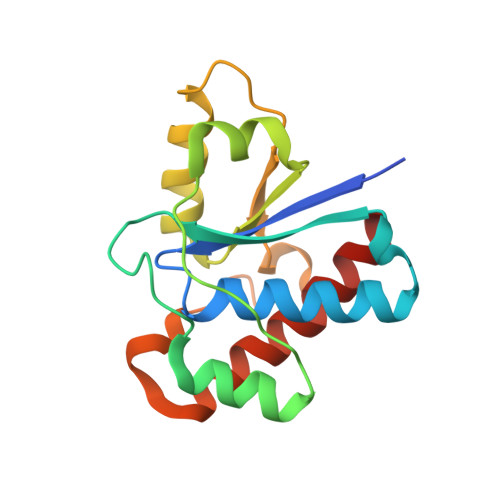Diabetes reversal by inhibition of the low-molecular-weight tyrosine phosphatase.
Stanford, S.M., Aleshin, A.E., Zhang, V., Ardecky, R.J., Hedrick, M.P., Zou, J., Ganji, S.R., Bliss, M.R., Yamamoto, F., Bobkov, A.A., Kiselar, J., Liu, Y., Cadwell, G.W., Khare, S., Yu, J., Barquilla, A., Chung, T.D.Y., Mustelin, T., Schenk, S., Bankston, L.A., Liddington, R.C., Pinkerton, A.B., Bottini, N.(2017) Nat Chem Biol 13: 624-632
- PubMed: 28346406
- DOI: https://doi.org/10.1038/nchembio.2344
- Primary Citation of Related Structures:
5JNR, 5JNS, 5JNT, 5JNU, 5JNV, 5JNW - PubMed Abstract:
Obesity-associated insulin resistance plays a central role in type 2 diabetes. As such, tyrosine phosphatases that dephosphorylate the insulin receptor (IR) are potential therapeutic targets. The low-molecular-weight protein tyrosine phosphatase (LMPTP) is a proposed IR phosphatase, yet its role in insulin signaling in vivo has not been defined. Here we show that global and liver-specific LMPTP deletion protects mice from high-fat diet-induced diabetes without affecting body weight. To examine the role of the catalytic activity of LMPTP, we developed a small-molecule inhibitor with a novel uncompetitive mechanism, a unique binding site at the opening of the catalytic pocket, and an exquisite selectivity over other phosphatases. This inhibitor is orally bioavailable, and it increases liver IR phosphorylation in vivo and reverses high-fat diet-induced diabetes. Our findings suggest that LMPTP is a key promoter of insulin resistance and that LMPTP inhibitors would be beneficial for treating type 2 diabetes.
- Division of Cellular Biology, La Jolla Institute for Allergy and Immunology, La Jolla, California, USA.
Organizational Affiliation:

















